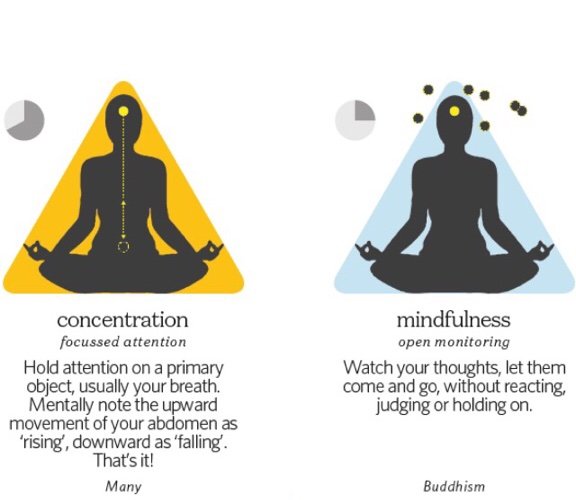
Meditation is a practice in which an individual uses a technique – such as mindfulness, or focusing the mind on a particular object, thought, or activity – to train attention and awareness, and achieve a mentally clear and emotionally calm and stable state. Meditation is practised in numerous religious traditions.
Meditation dates back thousands of years across many different cultures and often shares elements with spirituality. In modern times, meditation is used often as an effective means of managing stress, anxiety, insomnia, and pain, among other chronic conditions.
What Is Meditation?
In its simplest terms, meditation is the practice of deepening one’s awareness or focusing one’s mind for a period of time.
Some of the earliest evidence of meditation includes wall art from the Indus Valley that dates back to between 5,000 and 3,500 BCE. The images illustrate people sitting on the ground with their legs crossed, hands on their knees and eyes resting — in positions widely recognized as meditation postures. Descriptions of meditation techniques have also been found in ancient Indian scriptures from 3,000 years ago.
Types of Meditation

There’s no one single type of meditation, though techniques tend to overlap. Here’s a list of common types of meditation and how they are practised.
Mindfulness Meditation: This is the process of being fully present with what you are experiencing in the current moment — including your body and your thoughts- in a way that is concentrated, curious, and open. It is paying attention to our present moment experiences with openness, curiosity, and a willingness to be without experience. It’s a way of helping us live more in the present moment, not being lost in the past and future.
Mindfulness-Based Stress Reduction: This is a specific type of mindfulness meditation taught over an eight-week period using meditation and yoga. It usually involves group classes and daily mindfulness activities practised at home. Researchers are currently studying its effects on stress and certain health conditions.
Mindfulness-Based Cognitive Therapy: This is another type of mindfulness meditation, which combines facets of mindfulness-based stress reduction with cognitive behavioural therapy. It is a common type of meditation for treating depression.
Concentrative Meditation: Different from mindfulness meditation, which encourages being present in a curious and open way, concentrative meditation keeps the mind fixated on one object, like the body as it sits on a chair. It typically has you focus on one thing in order to concentrate, gather your focus, and calm your mind.
Mantra Meditation: This is a type of concentrative meditation that uses a repeated calming word, thought, or phrase to prevent distracting thoughts. The mantra can be said out loud or simply thought.
Transcendental Meditation: A style of mantra meditation that involves a personally assigned mantra, such as a word, a sound, or a small phrase, repeated in a specific way.
Guided Meditation: Another method of concentrative meditation, in which you form mental pictures of situations that you find relaxing. You might imagine that you’re in a beautiful garden with the birds chirping. So you’re using your imagination to create states of being.
Loving-Kindness and Compassion Meditation: The practice of directing well-wishes toward others and wishes to help oneself or another to suffer less. You may wish them happiness or peace or that they’re at ease, and what that does is it may affect the other person, but it’s really about cultivating it within ourselves.
Meditative Movement: This includes the traditional Chinese practices of qigong and tai chi, as well as some forms of yoga and dance. Generally, meditative movement is a term for forms of exercise that are done in conjunction with meditative attention to body sensations. Certain activities such as running or drawing, while not considered forms of meditation, can produce a meditative state for many people.
Meditation Changes the Brain
In recent years, a growing body of research has focused on how meditation affects the brain. Some studies suggest that practising mindfulness meditation can actually change the structures of the brain. While scientists are still working to understand the effects of this practice, it is generally believed that it correlates to improved emotional regulation.
Mindfulness meditation has been shown to activate the prefrontal cortex, an area of the brain associated with our higher cognitive functions, and deactivate the amygdala, an area of the brain associated with anger, fear, anxiety, and depression. It strengthens the neurological circuits that calm the part of the brain that acts as a trigger for fear and anger.
In one study, for example, imaging tests found increased brain activity in long-term practitioners of loving-kindness and compassion meditation, compared with people in states of non-meditative rest. The left prefrontal cortex, which is an area of the brain associated with happiness, was particularly activated.
Other research has found an increase in activity in another part of the brain, called the insula, after mindfulness training, compared with control groups. The insula is key to self-awareness of one’s own body and feelings.
Finally, other studies have found that mindfulness leads to an increase in the anterior cingulate cortex, and the caudate nucleus, areas that allow for nonjudgmental acceptance.
Health Benefits of Meditation
A growing body of research has found that meditation is beneficial to mental and physical health because of the effect it has on our stress response.
The primary health benefit from meditation appears to be related to the general shift in the autonomic nervous system that decreases sympathetic tone and increases parasympathetic tone. The sympathetic nervous system is our fight-or-flight response, while our parasympathetic nervous system is rest-and-digest.
As humans, we’re wired to fight or flight very easily, since it’s a survival mechanism. So we want and need more parasympathetic. When the parasympathetic system is stimulated, heart rate and breathing slow, stress hormones decrease, blood vessels dilate, and digestion is improved.
In recent years, a growing body of scientific evidence has shown how a meditation practice can help improve health, including mental and emotional health. Research suggests that people who practice meditation react better to stressful situations and have lower stress-related hormone levels and inflammatory responses than people who do not. For many people, meditation can help with emotional regulation, as well as improve attention, memory, and mood. Additionally, some research suggests that a meditation practice can help with managing negative emotions, such as anger.
Meditation and Chronic illness
Meditation can also be a helpful tool in managing chronic illnesses. While research is limited and larger, more long-term studies are needed, there’s some evidence that meditation may play a role in helping manage various conditions- from mental health disorders to chronic pain to skin ailments.
Chronic stress promotes an increased inflammatory load, chronic low-grade inflammation, and prolonged increased levels of cortisol (the stress hormone)- all of which are associated with increased chronic illness.
For instance, meditation may help you manage or improve:
- Depression and anxiety by reducing worry and rumination
- Blood pressure, by helping to alleviate stress
- Heart conditions like coronary artery disease and heart failure by reducing stress, controlling blood pressure, and improving the overall quality of life
- Chronic pain, by potentially changing how the brain responds to pain
- Sleep issues, such as insomnia and sleep disturbances, by increasing the body’s relaxation response, reducing worry and rumination, and alleviating mood disorders
- Gastrointestinal disorders, including irritable bowel syndrome (IBS) and irritable bowel disease (IBD), by suppressing the activities of genes that can cause inflammation
- Obesity, by encouraging mindful eating and aiding weight loss
- Diabetes, by reducing stress, improving mood, and encouraging positive healthcare behaviours and the development of positive coping skills
- Rheumatoid arthritis, by potentially improving pain intensity and depression symptoms
- Skin conditions like psoriasis and eczema by helping to reduce stress, a trigger for symptoms
- Multiple sclerosis, by improving pain, fatigue, and overall quality of life
- Cancer, potentially by changing the cellular activity of cancer survivors in a way that scientists believe may have protective benefits against disease
Are There Any Drawbacks to Meditating?
While research has shown that there are certainly many health benefits of meditation, not everyone will necessarily experience those positive effects. Indeed, some research finds that certain individuals may have negative experiences when meditating.
A meta-analysis of four decades of studies on meditation and mindfulness determined that these practices led to negative effects in about 8 per cent of people. The most common adverse effects were increases in anxiety, depression, and stress. The researchers could not determine what brought on these negative effects but note many factors could be at play, including the intensity of the practice, the competence of the teacher, and the vulnerabilities of the person doing the meditating (if they were already predisposed to depression or anxiety, for example). Yet the study authors say it’s not clear whether having a previous mental health issue will make an individual more at risk of a negative event and that it could happen to anyone.
People with mental health disorders like depression and anxiety may be more susceptible to feelings of inadequacy if they don’t feel like they’re getting meditation. Because meditation reminds us that we all to varying degrees have psychological agency- that we can shift our own attitudes and thought processes- there can potentially be those who are suffering with psycho-emotional imbalances, such as depression or anxiety, who may experience shame or self-deprecation when results are not realized at the same pace as others, or at the pace they might expect. This can cause many feelings of guilt or inadequacy. Those side effects may not be forever, though. One multicenter online survey of women in Spain found that although some reported side effects, they were short term and didn’t stop further practice. What’s more, the researchers say it’s unknown whether the negative side effects were because of the practice and can be considered inherent to it, or simply facilitate the emergence of undiscovered mental or physical problems
Similarly, another study found rates of side effects of meditation were similar to other psychological interventions and were also short term. While more research is needed in this area, experts say it’s important to note that meditation, just like any other practice, is not for everyone. But medically there’s no medication that works for everybody. If you’ve tried meditation and have found that it’s not for you, there are plenty of other avenues to explore that can help alleviate stress and anxiety.
The most important thing is that we can all find ways to reduce stress in our lives, whether that’s running or dancing or taking long walks in nature, and not assume that you’ve got to be a meditator in order to reduce stress.
Tips of Meditation for Beginners
If you’re new to meditation, you may find the practice intimidating. Luckily, once you know the basics, you can practice meditation just about anywhere at any time. Experts recommend the following tips to get started:
Explore different types of meditation: It’s helpful for beginners to explore the different forms of meditation to find the one they like best. Read about the various types and see where you might like to get started. There’s a whole variety to experiment with. If one doesn’t work for you or you don’t respond to it, try another one.
Find a teacher: Find a certified meditation instructor by going to your area. If you find an instructor on your own, do your homework and make sure they are certified.
Use tools to practice meditation on your own: If you prefer not to go to an instructor or there are no certified teachers in your area, you can still practice meditation on your own. Go to your local library and find a book on meditation, Watch the TV show or download one of the many meditation apps to your mobile phone or tablet.
Don’t get discouraged.: Oftentimes people will try meditation and feel like they’re failing because they can’t concentrate or do it correctly. This is normal. For most people, meditation does not come easily. We live in a state of perpetual distraction, and it’s so hard to stay focused. The key is to start out slow and keep your expectations in check. You can try meditating for five minutes, or you can try for one minute. There’s not a set time that you have to do it to feel the effects.
A Simple Meditation to Try
If you’re interested in trying meditation, We recommend the following five-minute exercise to get started:
- Find a quiet place to comfortably sit or lie down.
- Close your eyes if you wish and rest your hands in a comfortable position.
- Pay attention to your breath. Notice your inhales and your exhales.
- Observe how your abdomen is rising and falling or your chest is expanding and contracting as you breathe.
- Choose one of these aspects of your breathing to focus on: your chest, belly, or the air flowing in and out of your nose. If you are having trouble doing this, simply listen to the sounds around you and focus on one of them.
- Try to sustain your attention on the spot or sound you’ve chosen.
- If you notice your mind wandering, redirect your attention back to whatever you were focusing on.
- Repeat until you can do the same.
Financial and Business expert having 30+ Years of vast experience in running successful businesses and managing finance.







